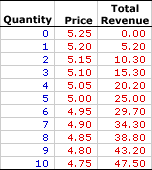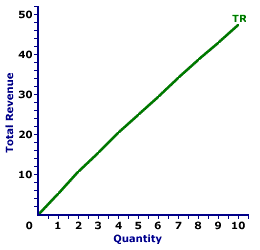
|
|
GOOD TYPES: We can identify four different types of goods based on two key characteristics -- rival consumption and excludability. Private that are rival in consumption and easily subject to the exclusion of nonpayers. Public goods that are nonrival in consumption and the exclusion of nonpayers is virtually impossible. Near-public goods that are nonrival in consumption and easily subject to the exclusion. Common-property goods that are rival in consumption and not easily subject to the exclusion.
Visit the GLOSS*arama
|
|


|

|
                           TOTAL REVENUE, MONOPOLISTIC COMPETITION: The revenue received by a monopolistically competitive firm for the sale of its output. Total revenue is one two bits of information a monopolistically competitive firm needs to calculate economic profit, the other is total cost. In general, total revenue is the price times quantity--the price received for selling a good times the quantity of the good sold at that price. For a monopolistically competitive firm, which has a modest degree of market control, total revenue increases at a decreasing rate. Two other revenue measures directly related to total cost are average revenue and marginal revenue. Total revenue is often depicted as a total revenue curve. Total revenue is important to the analysis a monopolistically competitive firm's short-run production decision. A monopolistically competitive firm generally seeks to produce the quantity of output that maximizes profit, which is the difference between total revenue and total cost.Total revenue can be represented in a table or as a curve. For a monopolistically competitive firm, the total revenue curve is a slightly curve line the emerges from the origin. The total revenue received by a firm is price times quantity, often expressed as this simple equation: | total revenue | = | price | x | quantity |
Monopolistic competition is a market structure with a large number of small firms, each selling similar but not identical goods. Monopolistically competitive firms have relatively complete knowledge and extensive mobility into and out of the market. These conditions mean monopolistically competitive firms are price makers, with some degree of market control. The can sell output within a narrow range of prices.Total Revenue,
Sandwich Style |  |
The table to the right summarizes the total revenue received by a hypothetical firm, Manny Mustard's House of Sandwich, for selling sandwiches in a monopolistically competitive market. The first column is the quantity of sandwiches sold, ranging from 0 to 10 sandwiches. The second column is the price Manny receives for selling his sandwiches, which ranges from $4.75 to $5.25 per sandwich.The third column is then the total revenue Manny receives for producing and selling different quantities of sandwiches. If Manny sells only one sandwich at $5.25, then he receives only $5.25. If he sells 5 sandwiches at $5 each, he receives $25. In each case, total revenue in column three is calculated as the quantity in the first column multiplied by the price in the second column. Consider a few highlights of these total revenue numbers. - First, total revenue is zero if Manny Mustard sells no sandwiches. This makes sense. If nothing is sold, no revenue is received.
- Second, as Manny sells more sandwiches he receives more total revenue. As a monopolistically competitive supplier, the demand for Manny's sandwiches is relatively elastic. In the relatively elastic range of a demand curve, such as that facing Manny, a decrease in price generates an increase in quantity and an increase in total revenue.
- Third and last, for each extra sandwich Manny sells, he receives extra revenue. This marginal revenue is less than the corresponding price. For example, the price needed to sell 5 sandwiches is $5. However, the extra revenue generated from selling the fifth sandwich is only $4.80.
Total Revenue Curve,
Sandwich Style |  |
Total revenue is commonly represented by a total revenue curve, such as the one displayed in the exhibit to the right. This particular total revenue curve is that for sandwich sold by Manny Mustard's House of Sandwich. The vertical axis measures total revenue and the horizontal axis measures the quantity of output (sandwiches). Although quantity on this particular graph stops at 10 sandwiches, the nature of monopolistic competition indicates it could go higher. This curve indicates that if Manny sells 1 sandwich for $5.25, then he receives $5.25 of total revenue. Alternatively, if he sells 10 sandwiches at $4.75 each, then he receives $47.50 of total revenue. Note that this curve is positively sloped, but the slope flattens slightly at large quantities. This occurs because Manny is a price maker and must charge a (slightly) lower price to sell a larger quantity of sandwiches.

Recommended Citation:TOTAL REVENUE, MONOPOLISTIC COMPETITION, AmosWEB Encyclonomic WEB*pedia, http://www.AmosWEB.com, AmosWEB LLC, 2000-2025. [Accessed: July 1, 2025].
Check Out These Related Terms... | | | | | | | | |
Or For A Little Background... | | | | | | | | |
And For Further Study... | | | | | | | |
Related Websites (Will Open in New Window)... | | | |
Search Again?
Back to the WEB*pedia
|



|

|
RED AGGRESSERINE
[What's This?]
Today, you are likely to spend a great deal of time flipping through mail order catalogs wanting to buy either a how-to book on wine tasting or a bookshelf that will fit in your closet. Be on the lookout for slow moving vehicles with darkened windows.
Your Complete Scope
This isn't me! What am I?
|

|
|
A half gallon milk jug holds about $50 in pennies.
|

|
|
"Experience keeps a dear school, but fools will learn in no other. " -- Benjamin Franklin
|

|
CBOE
Chicago Board Options Exchange
|

|
|
Tell us what you think about AmosWEB. Like what you see? Have suggestions for improvements? Let us know. Click the User Feedback link.
User Feedback
|


|


